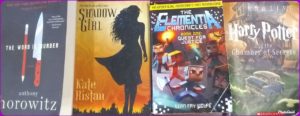Stephanie Ellis, a participant on Monster Librarian’s Facebook page, noted that right now there is a lot of great YA horror with girls as protagonists or major characters, but she’s having trouble finding any with boys as protagonists (writers, take note). I personally think it is lovely that we’re seeing more girls take on major roles in horror fiction, but in looking at this list by Kelly Jensen of YA horror fiction for the second half of 2019, 28 of the books have women as authors or editors (there is one anthology, slanted significantly toward women authors) and just three have men as authors. So many women writers getting published and lots of girls and women as protagonists or major characters is a great problem to have… unless you are looking specifically for YA horror with boys as protagonists and major characters. There are a lot of boys who are reluctant readers and an engaging YA read will grab them. Of course we shouldn’t all expect all books to be mirrors of our experiences, but there are now many more options for boys to read stories that showcase girls as protagonists and point-of-view characters, so there are more windows to look through, and doors to step through, in YA horror than ever before. A note: I’d like to see alternatives to traditional depictions of masculinity in future YA horror. It makes for some pretty great writing when you see it!
A few things about teens who seek out horror. In a very small 2007 study, Sharon McKool discovered that there are many kids who jump straight from reading Goosebumps to reading Stephen King (this included her own son). Based on my even earlier experience as a college student in the 1990s, I had more than one classmate who first engaged in reading when he first discovered Stephen King, and thought he was the greatest writer ever. A teenage boy was the first to hand me Anne Rice. My brother, not a reader, was gripped by In Cold Blood. YA is not a stopping point for these boys.
But many boys aren’t ready to make that jump and take the path that leads through YA fiction, and that’s awesome, because there are some great books available for them. There are even outstanding authors who first wrote for adults who have now also written YA horror, like Jonathan Maberry, Jeff Strand, and Steven Wedel (author of Murdered by Human Wolves, written for an adult audience, as well as co-author with Carrie Jones of one of the books Jensen mentioned as coming out later this year). These authors have the opportunity to introduce the adult horror genre to their young adult audiences craving more. However, since the current crop of upcoming YA horror fiction doesn’t seem to offer much in the way of boys as protagonists or major characters, here are a few older titles you can turn to. They are very different in tone, level of gore, age appropriateness, writing style, type of creature, and quality, so you can’t just hand the list over to any teenage boy and say “pick one.” But it is a starting place for making recommendations to the right kids. We’ve reviewed many, but not all, of these books. If the book was published before 2014, you’ll need to search the original MonsterLibrarian.com.com website to find it, but it should be pretty simple to find most of these reviewed elsewhere as well.
A Bad Day for Voodoo by Jeff Strand (2013) This Bram Stoker nominee is both funny and violent. Strand has written other books for younger readers that aren’t as violent, and comic horror for adults that can get very gory.
A Monster Calls by Patrick Ness (2011). This outstanding book should be in every collection. It is powerful and wrenching, and gorgeously illustrated.
Anna Dressed in Blood (2 book series): Anna Dressed in Blood (2011), Girl of Nightmares (2012) by Kendare Blake. Anna Dressed in Blood is consistently recommended as a “book to read” on recommendation lists for YA horror.
Escape from Furnace (5 book series): Lockdown (2009), Solitary (2010), Death Sentence (2011), Fugitives (2012), Execution (2012) by Alexander Gordon Smith. This action-packed dystopian series about a brutal underground prison for delinquent teenagers has some really difficult torture and body horror scenarios.
Five Nights at Freddy’s (2 book series): The Silver Eyes (2016), The Twisted Ones (2017) by Scott Cawthorn and Kira Breed-Wrisely. These are based on the popular video game Five Nights at Freddy’s.
Gone (8 book series): Gone (2008), Hunger (2009), Lies (2010), Plague (2011), Fear (2012), Light (2013), Monster (2017), Villain (2018) by Michael Grant
Heap House (The Iremonger Trilogy, #1) by Edward Carey (2014)
Lockwood & Co. ( 5 book series): The Screaming Staircase (2013), The Whispering Skull (2014), The Hollow Boy (2015), The Creeping Shadow (2016), The Empty Grave (2017) by Jonathan Stroud. These will probably appeal more to younger teens and are slanted toward mystery.
Miss Peregrine’s Peculiar Children (6 book series): Miss Peregrine’s Home for Peculiar Children (2011), Hollow City (2014), Library of Souls (2015), Map of Days (2018), The Conference of the Birds (upcoming) by Ransom Riggs. The use of vintage photographs and documents really sets these apart. A movie was made of the first book in 2016.
Peeps by Scott Westerfeld (2005)
Red Eye (10 book series): Flesh and Blood, Bad Bones, Savage Island, and Whiteout all have boys as protagonists. Tony Jones has done a summary of the 10 books in this UK series here.
Rot & Ruin (4 book series) : Rot & Ruin (2010), Dust & Decay (2011), Flesh & Bone (2012), Fire & Ash (2013). by Jonathan Maberry. This Stoker Award-winning series is essential. Bits & Pieces (2015) collects shorter pieces that take place in the same fictional world, and Broken Lands (2018) is the first book in a follow-up series.
Rotters by Daniel Kraus (2011)
Skeleton Creek (5 book series): Skeleton Creek (2009), Ghost in the Machine (2009), The Crossbones (2010), The Raven (2011), The Phantom Room (2014) by Patrick Carman. Skeleton Creek is an interactive series that directs readers to YouTube videos and websites intended to give the story a feeling of realism.
Slasher Girls & Monster Boys edited by April Genevieve Tucholke (2015). This is on HWA’s “Summer Scares” list for 2019.
The Apprenticeship of Victor Frankenstein (2 book series): This Dark Endeavor and Such Wicked Intent by Kenneth Oppel (reprinted 2012) I fangirl these ones! Kenneth Oppel is a very talented writer.
The Abused Werewolf Rescue Group by Catherine Jinks (2019)
The Devil’s Engine (3 book series): Hellraisers (2015), Hellfighters (2016), Hellwalkers (2017) by Alexander Gordon Smith
The Enemy (7 book series): The Enemy (2010), The Dead (2011), The Fear (2012), The Sacrifice (2013), The Fallen (2014), The Hunted (2015), The End (2017) by Charlie Higson. This post-apocalyptic series begins after nearly all the adults have been turned into cannabilistic zombies, and the children and teens are banding together in gangs, in hopes of surviving.
The Graveyard Book by Neil Gaiman (2009). This Newbery Award-winning book is outstanding and covers a boy’s life from young child to young man. The artwork by Dave McKean is startling and effective.
The Graveyard Book (graphic novel) by Neil Gaiman and P. Craig Russell (2018)
The Illuminae Files: Illuminae (2015), Gemina (2016), and Obsidio (2018) by Amie Kaufman and Jay Kristoff. These look more intimidating than they actually are. The stories are set up as a series of chat logs, emails, video transcriptions, photos, sketches, maps, and impressive double page illustrations, so even though the books are substantial they don’t need to be intimidating. They have a futuristic science-fiction setting.
The Monstrumologist (4 book series): The Monstrumologist, The Curse of the Wendigo, The Isle of Blood, The Final Descent by Rick Yancey. Will is the 12 year old apprentice to a “monstrumologist,” both scientist and monster-slayer, writing of his experiences. Set in the Victorian era, the language can be difficult and flowery. Although The Monstrumologist is a Printz Honor book, it is not for everyone. It will appeal most to readers with advanced vocabulary and a very strong stomach for gore and body horror.
The Thief of Always by Clive Barker (1992, reissued 2014). Clive Barker takes a different tone in this story of a house where it’s always a holiday. Many, many horror fans and writers have mentioned this as a gateway title to adult horror.
The Thief of Always (graphic novel) by Clive Barker, adapted by Kris Obrisko, art by Gabriel Hernandez (2010)
Thirsty by M.T. Anderson (1997, reissued 2010) Published in the days when YA horror was a rare treat, nobody had heard of that Harry Potter guy, and Amelia Atwater-Rhodes was a big deal, Thirsty remains memorable to me.
 Awards are not the end-all and be-all, but they do have meaning: libraries make purchases based on lists of award winners and recommended titles, and so do readers. When a well-regarded organization hands out an award, there is a ripple where often that book, or movie, or theater production, will also be held in high regard and rise to the top. It might even stay there decades later, after it has become dated or recognized as problematic (true of a number of early Newbery and Caldecott winners).
Awards are not the end-all and be-all, but they do have meaning: libraries make purchases based on lists of award winners and recommended titles, and so do readers. When a well-regarded organization hands out an award, there is a ripple where often that book, or movie, or theater production, will also be held in high regard and rise to the top. It might even stay there decades later, after it has become dated or recognized as problematic (true of a number of early Newbery and Caldecott winners).




Follow Us!